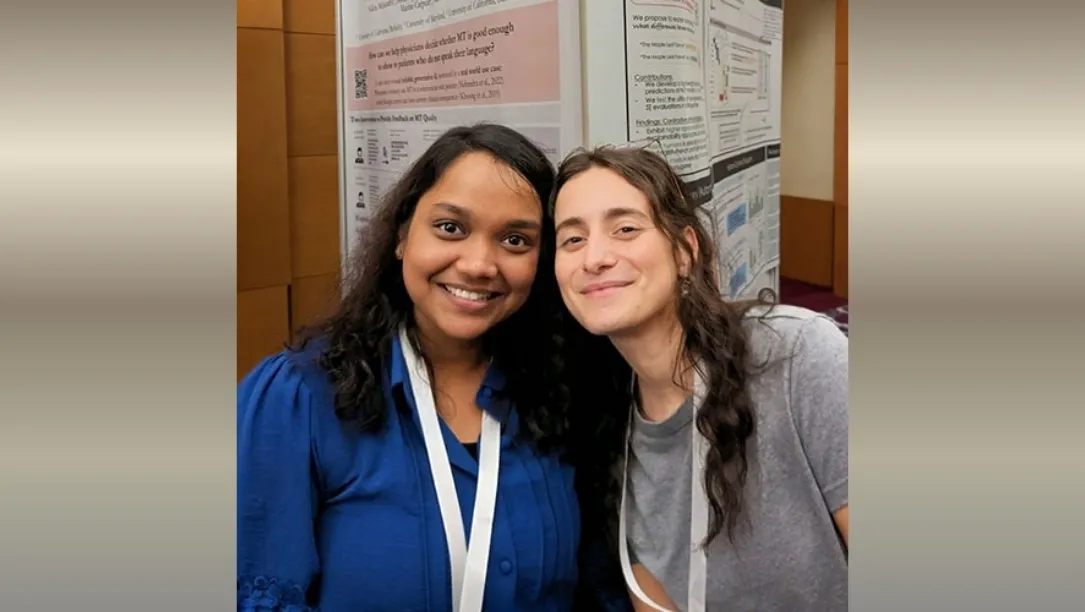
In 2018, Sweta Agrawal left India and Eleftheria Briakou left Greece to begin their Ph.D.s in computer science at the University of Maryland. Anxious to chase their dreams of a future in tech, they never imagined how their paths would cross on the road ahead.
Agrawal set her sights on earning a Ph.D. with a specific goal in mind.
“At the time, I really wanted to be a research scientist at Google,” says Agrawal, who received her Ph.D. in 2023. “It was just an insanely huge thing that I was making this decision, traveling all this distance to do something, and none of my family knew even what it meant or what it was supposed to do for my career. I just took a leap of faith.”
Briakou majored in electrical and computer engineering during college, but she couldn’t help feeling that something was missing. She found it at UMD.
“For me, applying for a Ph.D. was a way to keep exploring and keep my possibilities open,” says Briakou, who also earned her doctorate in 2023. “But the happy surprise was that during my Ph.D. at Maryland, I got incredibly passionate about what they called machine translation—using computer software to translate text from one language to another.”
At UMD, Briakou and Agrawal took on problem-solving research that pushed the boundaries of natural language processing and machine translation, and built a life-changing friendship along the way. They were both members of the Computational Linguistics and Information Processing (CLIP) Lab, which is supported by the University of Maryland Institute for Advanced Computer Studies (UMIACS), where they honed the skills and expertise that would later shape their work at Google.
Now, they’re working on the cutting edge of AI, leveraging the skill sets they developed at UMD to advance Google Translate. Using advanced machine learning, the app translates text, speech and images in real-time, communicating in more than 200 languages.
“Every single day it surprises me—the models we’re working with, the things that they can do, and how they can make things easier and boost productivity,” Agrawal says . “It’s all there, but there is so much farther to go in terms of understanding translation capabilities and where they come from. As AI researchers, I think we’re still at the forefront, but we need to know much more.”
Bonding over classwork, computers, and boundless curiosity, Agrawal and Briakou quickly found common ground. They shared not only similar research interests and classes, but also the same adviser, Marine Carpuat, director of the CLIP Lab and an associate professor of computer science with an appointment in UMIACS. Their mutual passion for language, technology and problem-solving soon turned academic collaboration into a close friendship.
“We are very invested in what we do,” Briakou said. “What would be a quick thirty-minute call with anyone else often turns into a three-hour deep dive for Sweta and me.”
That same depth carried into their friendship. Agrawal quickly found it easy to connect with Briakou, and their conversations soon extended beyond research to life outside the lab. She came to rely on Briakou’s feedback for nearly every project, crediting their friendship—and Briakou’s example—as a major influence on her own growth as a researcher.
In their Ph.D. work, Agrawal and Briakou explored new strategies to make machine translation more accurate, adaptable, and culturally aware—building models capable of handling subtle meaning differences across languages. Briakou’s work often focused on capturing these nuances to reflect cultural context and communication goals, while Agrawal’s research moved in a complementary direction.
“My work actually went in a complementary direction,” Agrawal adds. “I was working towards a more controllable machine translation, intentionally changing the meaning to fit the specific audience. In other words, how do we translate the same text differently to better suit, let’s say, a third-grade student, versus a native adult speaker, versus a non-native speaker?”
By 2022, the release of ChatGPT was accelerating interest in AI technology that could interact rapidly with users through text and speech. Advances in large language models (LLMs) continued to expand the possibilities for natural language processing, and for Briakou and Agrawal, real-world internships underscored the growing power of AI.
The two often found themselves switching places—one summer Briakou was at Meta while Agrawal interned at Google, and the next year they swapped. Those experiences, they say, marked the moment both shifted their focus to large language models, recognizing how quickly the technology was transforming the field.
After earning their Ph.D.s, Briakou joined Google as a research scientist in 2023, while Agrawal completed a postdoctoral position in Portugal before joining Google a year later. Now, working together again, they’re developing AI translation tools that help millions of people communicate across hundreds of languages every day.
Agrawal says recent advances have opened up new possibilities for translation, making it feasible to integrate reasoning into language models—something unimaginable just a few years ago. Today, their work focuses on exploring what these systems can achieve and understanding their limitations.
Briakou says that their shared goal is to create better models and products that make multilingual communication more accessible worldwide.
Both credit their time at UMD for forging a rare professional and personal bond. Briakou says finding someone who is both a close friend and a respected collaborator has been invaluable.
“For me, this has been the best part of all,” Agrawal agrees. “When you’re able to find an adviser, a friend and now a coworker in the same person, it’s amazing—just 100% incredible.”
—Story by Leslie Miller, College of Computer, Mathematical, and Natural Sciences